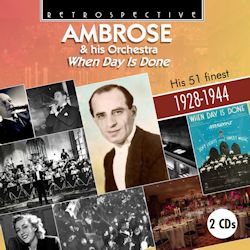 BUY NOW AmazonUK AmazonUS |
AMBROSE AND HIS ORCHESTRA
When Day is Done. His 51 Finest, 1928-44
|
CD 1
1. Happy Days Are Here Again
2. Sunshine
3. Singapore Sorrows
4. If I Had You
5. Cryin' For The Carolines
6. 'Leven Thirty Saturday Night
7. The 'Free And Easy'
8. The Peanut Vendor
9. I'm Thru With Love
10. Me!
11. Home
12. She Didn't Say 'Yes'
13. The Sun Has Got His Hat On
14. The Clouds Will Soon Roll By
15. Sweet Muchacha
16. Let's Put Out The Lights And Go To Sleep
17. How Deep Is The Ocean?
18. Lazybones
19. It's The Talk Of The Town
20. Who's Been Polishing The Sun?
21. The Continental
22. Embassy Stomp
23. I'm On A See-Saw
24. Hors D'oeuvres
25. Big Ben Is Saying 'Goodnight'
CD 2
1. Streamline Strut
2. Maracas
3. B'wanga
4. Anything Goes
5. I'll Never Say 'Never Again' Again
6. Copenhagen
7. She's A Latin From Manhattan
8. Limehouse Blues
9. The Piccolino
10. Night Ride
11. Wood And Ivory
12. Hick Stomp
13. Escapada
14. Champagne Cocktail
15. Cotton Pickers Congregation
16. Caravan
17. Deep Henderson
18. Moonlight On The Waterfall
19. Message From Mars
20. Two Sleepy People
21. Blue Skies Are Round The Corner
22. My Prayer
23. I'm In Love For The Last Time
24. I Don't Want To Walk Without You, Baby
25. Lili Marlene
26. When Day Is Done
Ambrose’s was the deluxe dance band orchestra of its time. There are numerous ways to approach its legacy and you can break things down by record labels. My first large-scale encounter with the recordings came via a Decca Vintage series gatefold LP which focused on recordings made for the label between 1933 and 1939, though there was a strong concentration on the years 1934-35. Then you can go further back to its pre-Decca HMV days. This is the comprehensive approach taken in this twofer allowing a 16-year span of recordings that allows one to eavesdrop on the long sequence of HMVs as well as the interregnum years of 1932-33 when the band turned up on Regal Zonophone and Brunswick, before the inauguration of that long Decca contract.
Unlike the jazzier Lew Stone, Ambrose could luxuriate in romantic balladry, a commercial trait emphasized by the appearance of at least two fiddlers on a number of tracks; occasionally he even sported more. But he also employed some of the best instrumentalists of the time; Sylvester Ahola, Max Goldberg, Tommy McQuater, Ted Heath, Lew Davis – along with George Chisholm (also in Ambrose’s ranks for a while) Britain’s finest trombonist of the 30s - Danny Polo, Sid Phillips, Harry Hayes and a host more. Ambrose also had the advantage of Britain’s most popular male vocalist until the arrival of Al Bowlly, namely Sam Browne, and the arranging skills of Lew Stone until he left in the early 30s to take over the remnants of Roy Fox’s band.
The tracks feature prominent vocals and moments of individual finesse from the soloists and sidemen. The hotter numbers – Hors d’oeuvres, Embassy Stomp (a Bert Barnes piece graced by his brilliant stride piano solo) and Cotton Pickers’ Congregation (a Sid Phillips tune) – are famous examples of the band firing on all cylinders. They play with great sensitivity in Ellington’s Caravan and in Deep Henderson. Ahola often soloed muted as did Heath inLazybones and there’s a striking and long violin solo in The ‘Free and Easy’; I assume it’s taken by Eric Siday.
Phillips turns Duke-ish in B’Wanga and there are maracas to be shaken in the rumba from A Cuban Suite written by Don Marzedo. The beautiful, talented Connee Boswell shows her effortless style in I'll Never Say 'Never Again' Again and during 1935 there are strong signs that someone has been listening to Benny Carter’s saxophone voicings; listen to Copenhagen. By 1936 the brass section, in particular, was absolutely top-notch and in Eric Breeze, Les Carew and Lew Davis the band sported the finest trombone contingent in Europe. The band still mined some corn – Valkyrie quotations et al - as well as sentimental ballads, such as provided by Vera Lynn, as I write the only survivor of the 1937 band, in Moonlight on the Waterfall.
I’m fairly sure that this is another in the sequence of ex-Living Era releases that Retrospective has reissued in its uniform livery, so if you have that much earlier release you’ll notice only some variation in track ordering and, of course, new artwork and notes. If you have the Living Era, you won’t need this. But this is a good twofer to own and contains the very best of Ambrose.
Jonathan Woolf